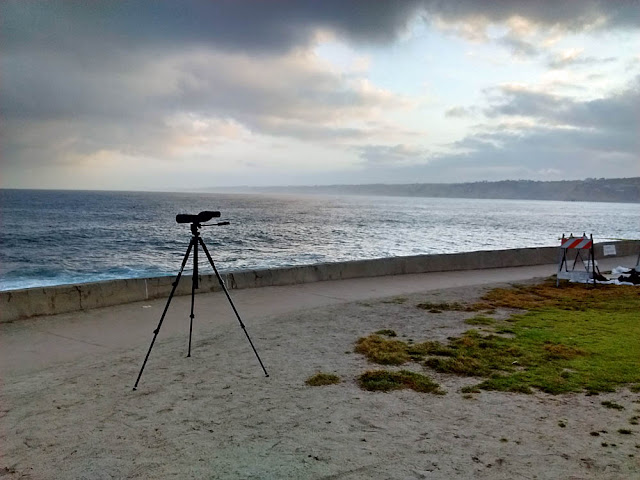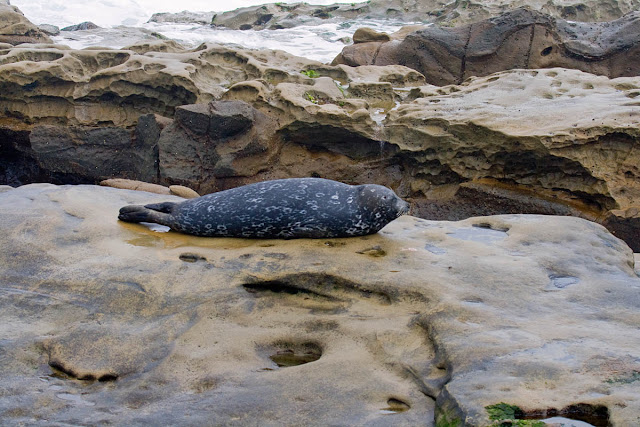Two point seven miles. It is 2.7 miles from the parking lot of Paso Picacho Campground to the summit of Cuyamaca Peak. It doesn't sound that far, but it is continuously uphill. The elevation goes from 4880' to 6512'. Let's see, that's 1632 feet of elevation change in 14,256 linear feet. That's an 11.4% grade, right? No wonder my feet, knees, legs, and hips hurt!
I just got back from hiking the trail this morning (May 15, 2016). I arrived in drizzly fog and 47F at 6:00 AM. It was a warmer 62F and sunny when I returned to my vehicle about 11:00 AM to rush home to Escondido. I've got lots of photos to share, and maps to create, so I won't actually publish this for 2 more weeks.
The Campground and the Peak are in Cuyamaca Rancho State Park south of Lake Cuyamaca. This is 11.7 miles south of Julian on Hwy 79. It is also almost the same mileage north of Descanso on Hwy 79 at the intersection of Interstate 8.
The campground was spared from the October 2003 Cedar Fire. Not so, the 3 peaks of the Cuyamacas--North, Middle, South. There is a little swale of trees that was spared on the South Cuyamaca Peak. Otherwise, the once impressive forests of Oak, Incense Cedar, Coulter Pine, and other conifers were incinerated.
The south peak of the Cuyamacas is the second highest mountain in San Diego County. At 6512' it is only 20 feet shorter than Hot Springs Mountain near Warner Springs. It is supposed to have much easier access. I don't know about that. I drove up Hot Springs Mountain in my Kia Soul in April 2014. Not that I should have, mind you, but I did. Then I hiked only a mile through the forest on rather level roads up top.
The advantage of Cuyamaca Peak is that the highway is paved all the way to the Paso Picacho Campground. And the "trail" to the top, though almost 3 miles, is paved. Yes, there is a radio/microwave relay on top and the single-lane fire road is steep but paved. I just wish that someone could walk the first mile-and-a-half of the trail for me, because the birds I want to see are on the upper half!
So, I checked out
The Hiking Guy web site. He has this hike listed as 6 miles round trip. Yep, that's right. And he has the hike as 2.5 hours. No, no, not so much. Of course, I was searching for birds to identify and photograph. It took me 3 hours to reach the summit, and another hour-and-forty-five minutes to return without too many diversions. Five hours. It took me 5 hours. And I feel like I rushed. If I ever attempt this again, I will make sure to spend the entire day to search more off-trail and wait patiently for birds to photograph.
eBird lists. Nearly all birders in the past seem to have combined their bird sightings for the entire hike. Then they generally placed their list marker either in the campground or on the summit. So, for birders wanting to plan a visit, the bird list is enticing, but useless to find the exact location of several rare and local birds.
So, on this trip I divided my hike into 7 lists between 8 points, as per the map above. And I included exact numbers. This way you may be able to know where on the hike I saw each species. Then you can plan a personal killer hike for yourself!
Target species are nesting Green-tailed Towhees, Thick-billed Fox Sparrows, and Dusky Flycatchers. All are very local as breeders in the County. This used to be a reliable spot to find White-headed Woodpeckers, but since the 2003 conflagration, only a couple have been noted. And as I mentioned, the eBird lists are poor for determining exactly where, though there are only pines near the peak and campground.
Most common species: Acorn Woodpecker (campground), House Wren (every one of my individual checklist locations), Spotted Towhee.
Use the map above to plan your hike on the paved Lookout Road.
A) Day use parking lot in Paso Picacho Campground. $8 day use fee. No dogs. The forest around the campground contains many noisy Acorn Woodpeckers.
B) Finding the beginning of the trail is a bit problematic. The easiest (so I'm told) is to ignore the park signs and take the maintenance road near the entry kiosk. Otherwise, walk through the campground to
space 69 to find the trailhead there.
A to B: 0.34 miles through the campground. Here's my eBird checklist. 19 species including Band-tailed Pigeon, 24 Acorn Woodpeckers, Oak Titmouse, White-breasted Nuthatch.
 |
| Campground meadow at parking lot |
C) West Side Trail crosses Lookout Road.
B to C: 0.27 miles from the campground to West Side Trail. Here's my eBird checklist. 9 species including the first of several heard-only Mountain Quails, 2 Black-chinned Sparrows, and 3 Lazuli Buntings.
 |
| Starting out. Burned pine and oaks from 2003. Cuyamaca Peak looks so-o-o-o far away! |
 |
| Looking back at Paso Picacho Campground with Stonewall Peak. |
 |
| Black-chinned Sparrow. Cuyamaco Rancho State Park. May 15, 2016. Greg Gillson. |
D) Azalea Spring Fire Road heads north across Lookout Road.
C to D: 0.52 miles from West Side Trail to Azalea Spring Fire Road. Here's my eBird checklist. 18 species including Costa's Hummingbirds, a late migrant Hermit Warbler, 6 Black-chinned Sparrows, the first 3 of the target Green-tailed Towhees, 5 Black-headed Grosbeaks, and 6 Lazuli Buntings.
E) Deer Spring is somewhere in the tangle of brush. The chaparral is especially dense here and this is the location of most sightings of Green-tailed Towhees and Thick-billed Fox Sparrows (though I didn't find Fox Sparrows this time).
D to E: 0.29 miles from Azalea Spring Fire Road to Deer Spring. Here's my eBird checklist. 9 species including 2 more calling Mountain Quail.
 |
| Green-tailed Towhee and Fox Sparrow habitat near Deer Spring. |
F) The remnant forest starts here with several Incense Cedars and then more pines.
E to F: 0.52 miles from Deer Spring to the remnant forest. Here's my eBird checklist. 13 species including 3 rather close--but still unseen--Mountain Quail, 2 Olive-sided Flycatchers, several Orange-crowned Warblers, and 2 more Green-tailed Towhees.
 |
| Olive-sided Flycatcher. Cuyamaca Peak. May 15, 2016. Greg Gillson. |
 |
| Looking back downhill. Early morning fog over Lake Cuyamaca. |
G) Burnt Pine Fire Road splits off and the Lookout Road begins its final steep ascent up Cuyamaca Peak.
F to G: 0.42 miles through the forest to Burnt Pine Fire Road. Here's my eBird checklist. 14 species including 2 Band-tailed Pigeons, the first Dusky Flycatcher, 7 Mountain Chickadees in the conifers.
 |
| Lower edge of the forest with Incense Cedar.
|
 |
| In the forest. |
 |
| Dusky Flycatcher habitat just below the summit on the north. |
 |
| Dusky Flycatcher. Cuyamaca Peak. May 15, 2016. Greg Gillson. |
Cuyamaca Peak Summit
G to summit of Cuyamaca Peak: 0.33 miles from Burnt Pine Fire Road to the summit. Here's my eBird checklist. 14 species including another Olive-sided Flycatcher, 4 Dusky Flycatchers on the southeast side out of the wind, 2 Hermit Warblers, and 8 Dark-eyed Juncos.
 |
| California Lilac |
 |
| Hermit Warbler. Cuyamaca Peak. May 15, 2016. Greg Gillson. |
 |
| On the summit looking north. A brisk damp breeze. |
On my way back down I lumped all the birds together, but placed notes in eBird for the unusual ones.
Summit to Parking Lot: 2.7 miles. Here's my eBird Checklist. 30 species including: Mountain Quail voices carry far, I recorded 3 individuals on the way down, 2 Anna's Hummingbirds were discovered right at the edge of the campground, I only detected 3 Dusky Flycatchers on the way down, Pygmy Nuthatches were missed on the way up but found in the forest and in the campground going back, 4 Green-tailed Towhees were found on the way down, some were in slightly different locations than on the way up, a male Bullock's Oriole was a new bird for the hike and, finally, a Townsend's Solitaire in the forest up top was a rare late spring surprise--could it be nesting in the county?
So there it is. I should sleep well tonight!






















































